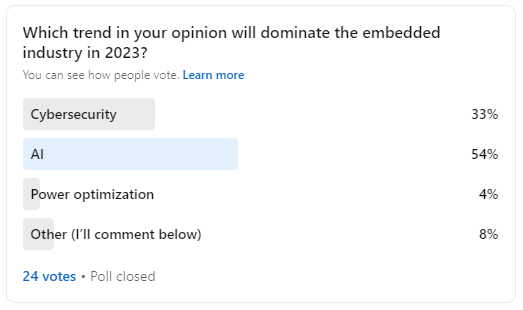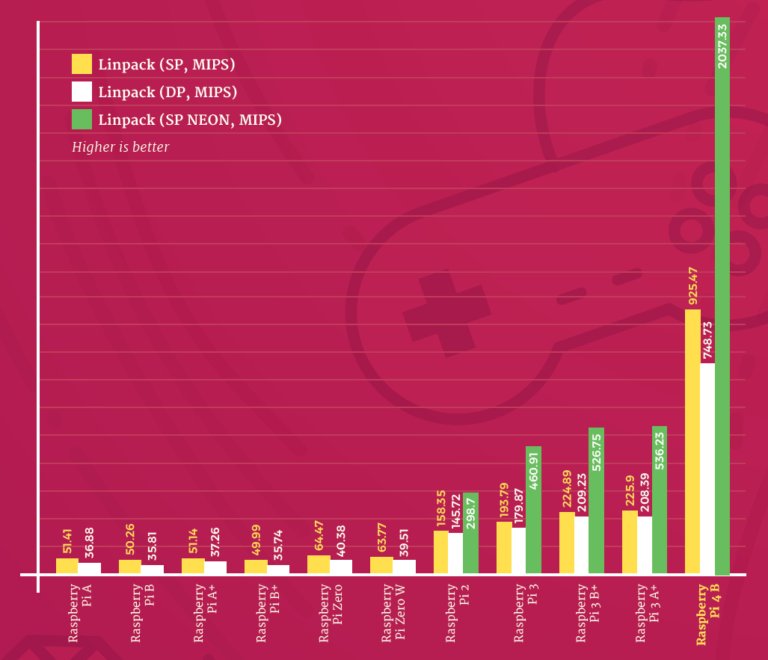5 Trends in Embedded Systems to Watch in 2023
15 February 2023
15 February 2023
As the world is drifting towards ingenious technologies, the embedded systems industry is evolving faster than ever. In 2021, the global embedded systems market was valued at $89.1 billion and is expected to reach $163.2 billion by 2031.
With their diverse functions and flexibility, embedded systems have become a backbone for many industries. A few examples are automation and robotics, automotive, and healthcare. From your central heating system to the fitness tracker, embedded systems are present in almost every aspect of life. The explosion of Internet of Things (IoT) technologies and increasing demand for advanced driver-assistance systems in electric and hybrid vehicles further accelerate the industry’s growth.
Embedded systems are becoming more compact, more powerful and more cost-effective. They come with new AI and security features. What are the driving forces behind those changes?
Let’s take a closer look at the top five trends in embedded systems that are most likely to shape the industry in 2023 and beyond.
With the rise of IoT technology and an increasing number of devices connected to the Internet, the risk of hacker attacks has emerged as a new threat to embedded systems. As the methods used by hackers are becoming more sophisticated, developing cybersecurity solutions is a new priority.

Hardware manufacturers are introducing new mechanisms to protect the devices. Microprocessors now come with built-in security features such as ARM TrustZone technology, secure boot, random number generation, cryptographic processing, tamper-proofing, secure key storage or JTAG protection. Operating systems involve secure storage for encrypted containers, full-disk encryption and kernel hardening. On the software level, engineers actively monitor all components of the development environment. Another important countermeasure is to implement strict identity management and access protection. All to secure intellectual property and client data.
“More and more clients are asking us about security solutions, which shows the increasing awareness of the subject. Data security and encryption have virtually become a standard that Tronel implements on a daily basis,” says Artur Gdański, Embedded Solutions Manager at Tronel.
In the battle where embedded engineers are constantly coming up with new security solutions and hackers use more and more innovative methods to get around them, the clear winner is the user who benefits from the growing level of security each year.
With the buzz around tools such as ChatGPT, artificial intelligence is without a doubt one of the top technology trends this year. It’s not surprising that over half of the respondents in our LinkedIn poll pointed to AI as a most prominent issue among trends in embedded systems that is likely dominate the industry this year.

Source: Tronel @ Linkedin
Smart machines that simulate human intelligence can lead to endless opportunities. But how AI benefits embedded systems? The answer is embedded AI. The application of machine and deep learning in software at the device level.
Until recently, artificial intelligence computations were performed at a data center in a cloud. Now, AI models can be run on session border controllers, graphics processing units and SoCs. The results are used directly by devices to perform a task or action. For example, embedding artificial intelligence models on SoCs allows for optimizing the chip’s architecture. This results in lowering power consumption and calculation time. In turn, combining AI and IoT in factories leads to predictive maintenance, improved efficiency and cost reduction.
On top of that, there are multiple tools and libraries for the design and testing of embedded solutions. Many of which support the work of engineers with artificial intelligence.
“ChatGPT can already generate code for a specific embedded hardware and its answers are close to accurate,” says Damian Gzik, Software Engineer at Tronel. With its current capabilities, AI is unlikely to take away programmers’ jobs, but it can be used as a helping tool. “The question is not whether AI will replace embedded engineers or not in the future. We should rather ask if we will be able to critically assess its outputs and if it brings value or not,” Artur Gdański points out.
With prices of AI hardware decreasing, we expect to see a rise in embedded systems that include AI features this year. Yet, given the enormous amount of work to yet be completed in the area we’re likely to see real breakthroughs over the next 10 years or more.
The emergence of new technologies in the embedded world, such as IoT, machine learning and AI that use complex algorithms, requires solutions with high-speed processors and faster memory.

In the wider IT world, the computation speed is increasing rapidly. The world’s first supercomputer, CDC 600, released in 1964 reached a top speed of 40MHz. 1 MHz represents 1 million cycles per second. The latest supercomputer, Frontier, can process 1.102 quintillion (a billion billions!) operations per second.
Processors, the Internet, and systems are becoming ultrafast. It is predicted that 6G will reach a maximum speed of one terabit per second (Tbps), which is 100 times faster than 5G.
“There is no official documentation about 6G, all this information is based on predictions of mobile phone manufacturers or telecommunications networks. But 1 Tbps seems very likely,” explains Łukasz Finster, 5G Solutions Architect at Tronel.
In the meantime, the use of multi-core processors in embedded systems design is likely to continue rising in popularity. Multi-core processors not only increase speed but also allow for the simultaneous processing of several tasks. However, in chasing new speed records, the current challenge remains compromising clock speed with power efficiency.
Seeking to reconcile efficiency with cost-effectiveness, the embedded systems industry is heading towards low-power design. Engineers are increasingly monitoring the energy consumed by hardware and software. This is done by running tests and implementing wireless radio technologies and power regulators. Simultaneously, manufacturers are developing batteries that store more power but cost less to produce. The use of alternative energy sources such as solar panels is increasing rapidly.
Over the last ten years, we have seen tremendous improvements in embedded hardware efficiency. To give an example, the Raspberry Pi 4 (2019) massively outperformed Raspberry Pi 3 (2016) at floating-point calculations while its power consumption increased only slightly. Specialist solutions such as machine learning and neural processing will lead to even more exponential gains in hardware power efficiency over the next decade.

Source: The MagPi Magazine
We’re also observing an increased use of Systems on the Chip (SoCs) that integrate all components of the system (memory, timers, communication interfaces) into a single chip. SoCs are expected to drive most embedded systems than general-purpose central-processing units (CPUs) due to their low power consumption, high performance and compact design.
An interesting example of an embedded system designed for power optimization is Cautus Geo’s data logger for which Tronel’s engineers developed firmware and applications. The system operates on a solar battery without an external power supply. It can last even several years without servicing by engineers. The compact design and efficiency make it a perfect solution to be placed, for instance, on mountain slopes.

Cautus Geo’s data logger. Read the full case study
With energy prices increasing and customers seeking more environmentally friendly solutions, power optimization is one of the trends in embedded systems that seem to be more important than ever before.
DevOps has brought massive improvements to general software development over the last decade. However, until recently, embedded engineers have remained somehow reluctant to its principles. Traditionally, embedded software was written, deployed and then left isolated. If something changed, the process of rebuilding the entire system from scratch was extremely time-consuming.
With the rise of cloud-native computing, IoT and edge technologies, such a static approach is simply no longer possible. Systems with even billions of embedded devices connected to the Internet require a new way of designing, testing and maintaining. Even smaller systems need to be frequently updated, supported and secured. Bringing DevOps to embedded development provides a set of tools that automate the workflow leading to faster delivery.
It’s amazing to see that embedded engineers around the world are increasingly implementing DevOps practices into embedded development: from setting up a toolchain using Docker, through automating building processes with CI/CD servers, to adding code analytics and performing all types of testing. At Tronel, the implementation of DevOps to projects allows us to not only increase code quality but also to optimize development costs and fully customize the created solutions.
Understanding the ever-changing landscape of embedded technologies and integrating them into your business can be challenging. Yet, recognizing the potential of trends in embedded systems to your industry is the first step to achieving competitive advantage.
Our experts are more than happy to advise you on the best embedded technologies available to your organization. Get in touch and discover what solutions will most benefit your business.
If you want to learn about the most recent trends in embedded systems, check out our latest article.
By Monika Wozniak

